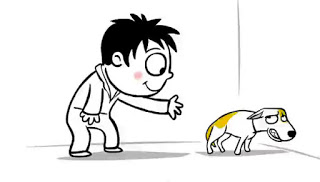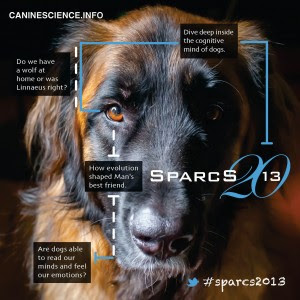Dogs
Hey Mia!
--> Dogs in Research
PUPPY PROBLEMS?
I recently covered the SPARCS conference on #SciAmBlogs, who will be there & what to expect, at You’re invited to a canine science conference. Take a look!
Cheers!
- Set Sparcs To Your Brain: Canine Science For Everyone! (with Ticket Giveaway)
JOIN US! #SPARCS2015 - INFO & TICKET GIVEAWAY The goals of the Society for the Promotion of Applied Research in Canine Science are simple: SPARCS is an initiative to promote research and education in canine science. Their profits fuel research...
- Why Does My Dog Do That??
DYBID? gets to know a #NYC dogHi Mia, Everything is different. For the past two years I have been writing to you as you play out life in Australia -- “in the future” as I like to say. Others might call it a different time zone. To each their own....
- Pass Me The 'dog Book'
(Source)Hi Mia! So many books. Written about dogs. Most I see at the airport, memoirs of someone’s ‘very special relationship’ with a 'very special' dog, another about dogs ‘racing in the rain,’ (seems like it would be a pretty short...
- 2014: Canine Science For All
Wendy74ca's photostream used with permission via Crazy and LittleHi Mia! I couldn’t agree with you more! It has been a long time since we chatted about what we’re up to. 2014 is off to a great start, apart from the fact that it is your summer...
- Scientific American Gave Us Our First Shout Out!
Last week, we received an awesome surprise (well, Mia received the surprise first because she has a smartphone). Bora Zivkovic, Blog Editor at Scientific American, named Do You Believe in Dog? Blog of the Week! BLOG OF THE WEEK! This brought our...
Dogs
Dogs in Review: May 2013
 |
| Canine Science! Everywhere! AHHH! (source) |
Hey Mia!
Didn’t May come and go in a flash? Is it possible to ask for an extension? The world of canine science was bopping last month, so here’s a review of things I would have liked to cover in more detail, if I were granted a two-week extension:
--> Dogs in Research
Dogs rocked peer-reviewed journals last month! As you mentioned, the Horowitz Dog Cognition Lab published an article in a recent issue of Learning and Motivation. We looked at the olfactory experience of companion dogs, and I'm sure I'll talk more about our paper later. The issue will include a number of dog-centric, peer-reviewed articles covering a variety of canine cognition topics such as olfaction, memory, physical cognition, and the influence of humans on dog behavior. Here’s a brief overview of a few of the studies:
MAGIC BONES
Pattison et al. The case of the magic bones: Dogs’ memory of the physical properties of objects.
How can I not mention a paper talking about magic bones? “Using a procedure popular with preverbal infant researchers, [the researchers] allowed dogs to initially observe a bone and then to subsequently view the bone changed in either size or color. Dogs gazed longer at a bone changed in either way, compared to a control presentation of an unchanged bone. Dogs apparently encoded and remembered both the size and color of the bone.” *
OLFACTION
Hall et al. Training domestic dogs (Canis lupus familiaris) on a novel discrete trials odor-detection task.
“[Domestic] dogs can be trained to detect a distinct odor (anise) buried in pine shavings. However, it took dogs about 60 trials to reach an average performance level of 80% correct choices, and dogs learned much better when a human experimenter delivered food reward than when the reward was buried with the odor cue.” *
SOCIAL INFLUENCE
Pongrácz et al. “We will work for you” – Social influence may suppress individual food preferences in a communicative situation in dogs.
“[Dogs] would repeatedly choose a bowl containing a carrot over a bowl containing preferred sausage if a human pointed to the carrot bowl. In a delayed response test, dogs regularly search at the location where they last saw food disappear.” *
DOGS AND WORDS
Pilley. Border collie comprehends sentences containing a prepositional object, verb, and direct object.
 |
| Chaser knows words (source) |
A border collie named Chaser initially captured headlines in 2011 as “the smartest dog in the world” when research published in Behavioral Processes reported that she knew the names of over 1,000 different objects.
Pilley’s current article investigated Chaser’s attention to the syntactical relationships between words, like differentiating “to ball take Frisbee” from “to Frisbee take ball.”
What’s going on with “wordy dogs” like Chaser? How did they get this way? And how can we test whether the dogs in our homes understand our words as we intend them?
- Do Dogs Understand Our Words? The Dogs Weigh In. Scientific American
- Do Dogs Understand Our Words? The Bark Magazine
PUPPY PROBLEMS?
In other canine science news, I was happy to see that the blog Companion Animal Psychology (twitter: @CompAnimalPsych) covered a recent publication by Frank McMillan et al investigating behavioral problems in puppies from pet stores vs puppies from non-commercial breeders. According to the study: What were the behavioral differences between pet store and breeder-obtained dogs? Read on!
YAWNING IN DOGS MEANS...
Over at Not bad science on Scientific American Blogs, @Felicity__M discusses a study of yawning behavior in dogs. Check out her coverage of the recent paper, Buttner et al. Contagious yawning, social cognition, and arousal: an investigation of the processes underlying shelter dogs’ responses to human yawns.
--> Dog Bite Prevention Week 2013
Apparently, the third full week of May is dog bite prevention week, but in my mind, every day is (or should be) dog bite prevention day. I don’t want to be bitten by a dog, and also I don’t want to give a dog the experience of biting me. So how do we prevent dog bites?
Apparently, the third full week of May is dog bite prevention week, but in my mind, every day is (or should be) dog bite prevention day. I don’t want to be bitten by a dog, and also I don’t want to give a dog the experience of biting me. So how do we prevent dog bites?
- My primary strategy to avoid being bitten is to not be a child. Yes, that is cheeky, but children are more likely than others to be bitten by dogs, which we’ve discussed in earlier posts, Dogs and babies: Not always cute and The Science Surrounding Children & Dogs: Part 3 (The Ugly).
- I also avoid bites by not interacting with dogs like this:
 |
| Watch Sophia Yin Dog Bite Prevention Video |
- Instead, I ask dogs whether they want to interact, as recommended in a great post by Khris Erickson, the Humane Educator at HAWS, Humane Animal Welfare Society in Wisconsin.
- If dogs indicate that they are not into interacting, then we don't interact. It's that simple. What I sometimes find is that owners of "so friendly" dogs want to push an interaction even if the dog is giving "not right now" indications. A dog can still be "uber-friendly" without wanting to interact all the time with everyone. I've been thinking about this a lot recently as NYC enters summer and dogs are looking hotter and hotter, and potentially experiencing some physical discomfort.
- I also think about context, practicing interventions and what a leash can (and can’t) prevent. Patricia McConnell, CAAB, offers in-depth insights into this topic over at her blog, The Other End of the Leash, in the post 'Dog Bite Prevention 2013.'
- When it comes to preventing dog bites, I frequently check out The Blue Dog, a website aimed at educating children about dogs. I first learned about The Blue Dog at the 2nd Canine Science Forum. The website houses resources and research on children and dog bites, in addition to providing general dog information:
- Research on dog bites
- Research on dog bite prevention
--> Up next: Some of the leading canine science researchers will be presenting at a Canine Science Conference, SPARCS, June 28-30, 2013. The best part is, anyone in the world can join, either in a conference hall in Redmond, WA, or streaming live to your living room.
 |
| (source) |
I know your life is currently heavily focused on The Big W, and I’m not talking about the best movie ever, It’s a Mad, Mad, Mad, Mad World. Hoping for an update on working dog welfare!
Cheers!
Julie
* summary by Macpherson K. & Roberts W.A. (2013). Exploring the canine mind: Studies of dog cognition, Learning and Motivation, DOI: 10.1016/j.lmot.2013.04.006
© 2013 Julie Hecht
© 2013 Julie Hecht
- Set Sparcs To Your Brain: Canine Science For Everyone! (with Ticket Giveaway)
JOIN US! #SPARCS2015 - INFO & TICKET GIVEAWAY The goals of the Society for the Promotion of Applied Research in Canine Science are simple: SPARCS is an initiative to promote research and education in canine science. Their profits fuel research...
- Why Does My Dog Do That??
DYBID? gets to know a #NYC dogHi Mia, Everything is different. For the past two years I have been writing to you as you play out life in Australia -- “in the future” as I like to say. Others might call it a different time zone. To each their own....
- Pass Me The 'dog Book'
(Source)Hi Mia! So many books. Written about dogs. Most I see at the airport, memoirs of someone’s ‘very special relationship’ with a 'very special' dog, another about dogs ‘racing in the rain,’ (seems like it would be a pretty short...
- 2014: Canine Science For All
Wendy74ca's photostream used with permission via Crazy and LittleHi Mia! I couldn’t agree with you more! It has been a long time since we chatted about what we’re up to. 2014 is off to a great start, apart from the fact that it is your summer...
- Scientific American Gave Us Our First Shout Out!
Last week, we received an awesome surprise (well, Mia received the surprise first because she has a smartphone). Bora Zivkovic, Blog Editor at Scientific American, named Do You Believe in Dog? Blog of the Week! BLOG OF THE WEEK! This brought our...
